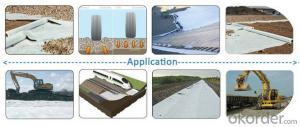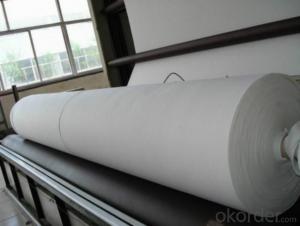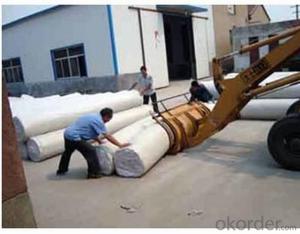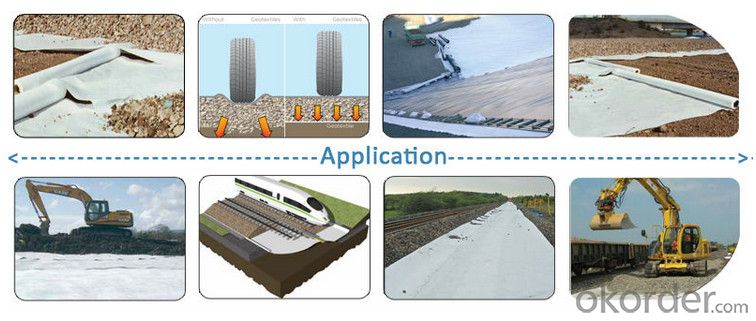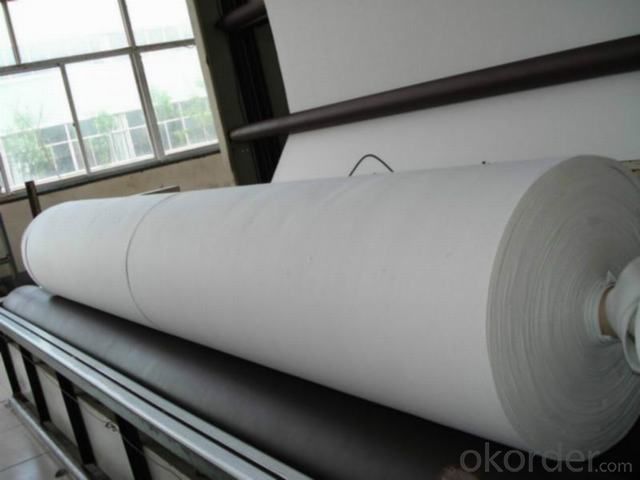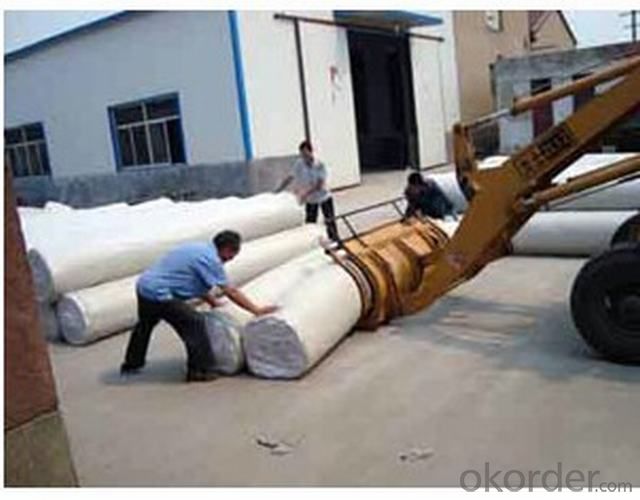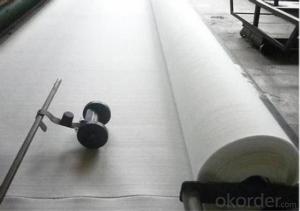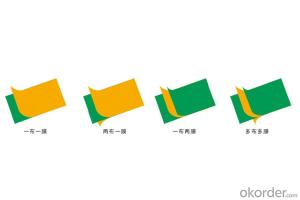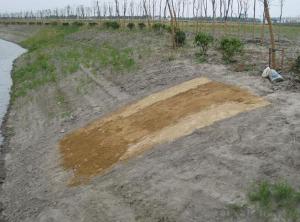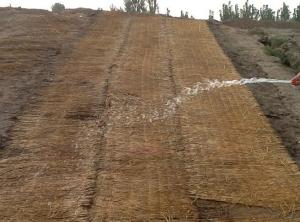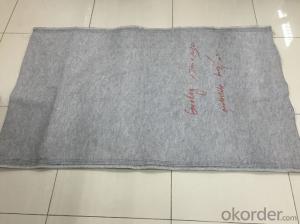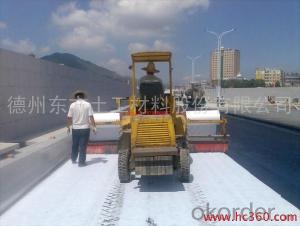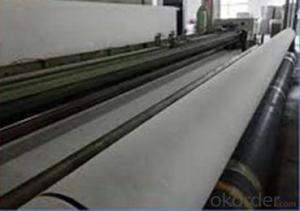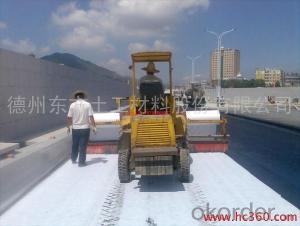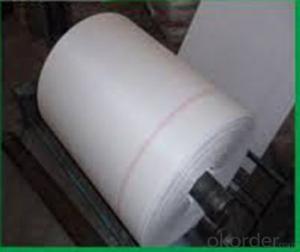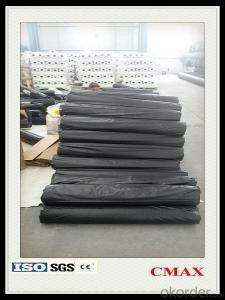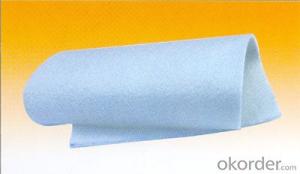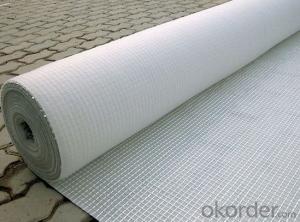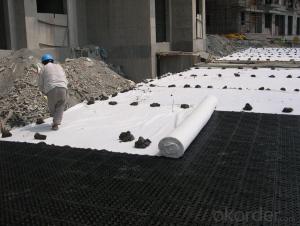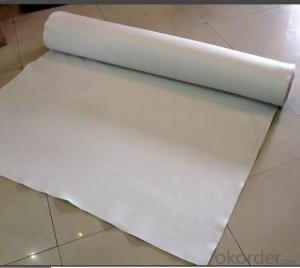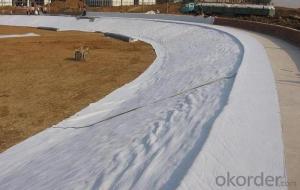Malla Geotextil Precio Needle Punched Nonwoven Geotextile for Road and Highway Construction
- Loading Port:
- Qingdao
- Payment Terms:
- TT OR LC
- Min Order Qty:
- 20000 m²
- Supply Capability:
- 1500000 m²/month
OKorder Service Pledge
OKorder Financial Service
You Might Also Like
Specifications of Needle Punched Nonwoven Geotextile:
Polyester Filament Needle Punched Geotextile/nonwoven
Fine permeability and filtering performance
Acid and alkali resistance
Features of Needle Punched Nonwoven Geotextile:
High strength, good capacity of elongation and high biology tolerance, alkali tolerance, acidity tolerance, weather resistance, good filtration and fine drainage capacity etc. With good cost performance, easy in construction and use effects.
Application of Needle Punched Nonwoven Geotextile:
1. Water conservancy projec: seawall, dike,river canal engineering;Reservoir reinforcement engineering; Reclamation engineering; Flood control engineering.
2.Highway,railway and airport project: soft foundation reinforcement; Slope protection; Pavement structure layer reflective crack prevention; Drainage system; Greening belt.
3.Electrical engineering : Nuclear infrastructure;Thermal power ash dam project;Hydropower project.
Technical Data Sheet of Needle Punched Nonwoven Geotextile:
| Index Spec. Article | 100 | 150 | 200 | 250 | 300 | 350 | 400 | 450 | 500 | 600 | 800 |
1 | Quality error in unit area,% | -6 | -6 | -6 | -5 | -5 | -5 | -5 | -5 | -4 | -4 | -4 |
2 | Thickness,mm≥ | 0.8 | 1.2 | 1.6 | 1.9 | 2.2 | 2.5 | 2.8 | 3.1 | 3.4 | 4.2 | 5.5 |
3 | Width error,% | -0.5 | ||||||||||
4 | Breaking strength,KN/m≥ | 4.5 | 7.5 | 10.0 | 12.5 | 15.0 | 17.5 | 20.5 | 22.5 | 25.0 | 30.0 | 40 |
5 | Elongation at break,% | 40~80 | ||||||||||
6 | CBR puncture strength,KN≥ | 0.8 | 1.4 | 1.8 | 2.2 | 2.6 | 3.0 | 3.5 | 4.0 | 4.7 | 5.5 | 7.0 |
7 | Effective aperture 090(095),mm | 0.07~0.2 | ||||||||||
8 | Vertical permeability coefficient , cm/s | K X (10-4-10-3) K=1.0~9.9(K=1.0~9.9) | ||||||||||
9 | Tearing strength,KN≥ | 0.14 | 0.21 | 0.28 | 0.35 | 0.42 | 0.49 | 0.56 | 0.63 | 0.70 | 0.82 | 1.1 |
FAQ:
What is the main application of Needle Punched Nonwoven Geotextile?
The main application of our Short Fiber Nonwoven Geotextile is as follows: The highway, railway, soil-stone dam, breakwater, airport, backfill soil of retaining wall, slope protection, etc.
Where is your main market?
Our main market is in Middle East, South America and some African countries.
What is your advantages for Needle Punched Nonwoven Geotextile?
One of the largest manufacturer of PP Woven Geotextile for Construction
with advanced equipment, big production capacity and excellent quality.
- Q: Woven geotextile customs code is how much
- The answer was deleted by google
- Q: are they used for same purpose with just different terminology?
- Geotextiles And Geomembranes
- Q: How are geotextiles used in slope stabilization?
- Geotextiles are used in slope stabilization by providing reinforcement and erosion control. They are installed in layers or grids along the slope to increase its stability, prevent soil erosion, and promote vegetation growth. The geotextiles act as a barrier, preventing the movement of soil particles while still allowing water to drain through. This helps to retain the soil and prevent it from sliding or eroding, ultimately stabilizing the slope and protecting it from further damage.
- Q: What are the key considerations for geotextile installation in cold climates?
- Some key considerations for geotextile installation in cold climates include selecting a geotextile that is suitable for low temperatures, ensuring proper ground preparation and compaction to prevent frost heaving, using appropriate installation techniques such as anchoring or weighting the geotextile to prevent movement, and considering the potential for snow accumulation and its effects on the geotextile's performance. Additionally, monitoring and maintenance during winter months is crucial to address any potential damage caused by freezing and thawing cycles.
- Q: How do geotextiles help in the prevention of clogging in drainage systems?
- Geotextiles help in the prevention of clogging in drainage systems by acting as a filter. They allow water to pass through while trapping fine particles and preventing them from entering the drainage system, thereby reducing the risk of clogging and maintaining the system's efficiency.
- Q: What are the advantages of using geotextiles over traditional construction materials?
- Geotextiles offer several advantages over traditional construction materials. Firstly, they provide enhanced stability and reinforcement to the soil or other substrates, reducing the need for extensive excavation or additional structural support. Secondly, geotextiles are permeable, allowing water to pass through while preventing soil erosion, thus improving drainage and reducing the risk of flooding. Additionally, geotextiles are lightweight and easy to handle, making them cost-effective and efficient to install. Lastly, these materials have high resistance to environmental factors such as chemicals, UV radiation, and biological degradation, enhancing their longevity and durability. Overall, geotextiles provide a versatile and sustainable solution for a wide range of construction applications.
- Q: Can geotextiles be used in the protection of embankments?
- Yes, geotextiles can be used in the protection of embankments. Geotextiles are permeable textile materials that are placed in the soil to enhance its engineering properties. When used in embankments, geotextiles help in soil stabilization, erosion control, and drainage, thereby protecting the embankment from erosion, excessive water flow, and potential damage.
- Q: Are geotextiles resistant to puncture?
- Yes, geotextiles are designed to be resistant to puncture. They are typically made from durable materials such as synthetic fibers or woven fabrics that offer excellent puncture resistance. This helps ensure their effectiveness in various applications where protection against punctures, such as in soil stabilization or erosion control, is crucial.
- Q: What are the standards and regulations governing geotextiles?
- The standards and regulations governing geotextiles vary depending on the country and its specific requirements. However, some common standards and regulations followed globally include those set by the International Organization for Standardization (ISO) and the American Society for Testing and Materials (ASTM). These standards typically cover aspects such as geotextile materials, design guidelines, testing methods, and performance requirements. Additionally, specific regulations related to geotextiles may exist at the national or regional level to ensure their proper use and compliance with environmental and safety standards.
- Q: Can geotextiles be used in waste containment projects?
- Yes, geotextiles can be used in waste containment projects. They are commonly employed as liners or covers in landfill sites, helping to prevent the migration of contaminants and providing stability to the waste. Geotextiles can also be used to reinforce the soil in waste containment structures, enhancing their strength and durability.
Send your message to us
Malla Geotextil Precio Needle Punched Nonwoven Geotextile for Road and Highway Construction
- Loading Port:
- Qingdao
- Payment Terms:
- TT OR LC
- Min Order Qty:
- 20000 m²
- Supply Capability:
- 1500000 m²/month
OKorder Service Pledge
OKorder Financial Service
Similar products
Hot products
Hot Searches
Related keywords
